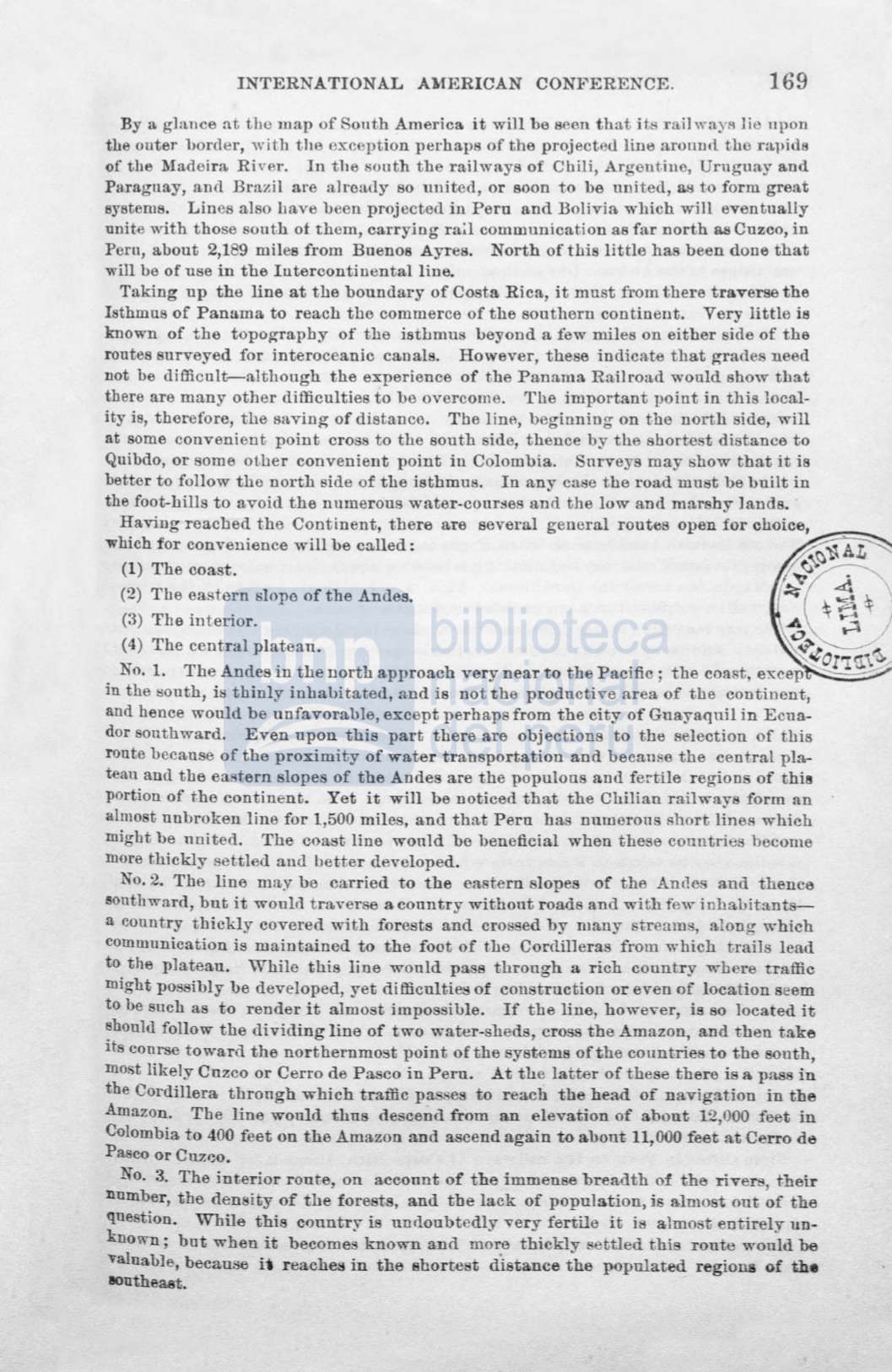

INTERNATIONAL AMERICAN CONFERENCE.
169
By a glance at tbe map of Soutb America. it will be seen that Hs railways Jie npon
the outer border, ·with the cxception perhaps of the projected line arounrl thc rapids
of the Madeira River.
In the sonth tbe railways of Cbili, Argentina, Uruguay
a.ndParaguay, and Brazil are already so united, or soon to be united, asto form great
systems. Lines also Lave b een projected in Peru and Bolivia wbich wi11 eventually
unite witb tbose south ot them, carryiug
ra~l
communication as far north
as
Cuzco, in
Peru, about 2,189 miles from Buenos Ayres. North of this little has been done that
will
be of use in the Iutercontinental line.
Taking up the line at the boundary of Costa Rica, it must from there traverse the
Isthmus of Panllma to reach the commerce of the southern contineut. Very little is
known of the topograpby of the istbmus beyond a few miles on eitber side of the
routes surveyed for interoceanic canals. However, these indicate that grades need
not be difficult--although the experience of the Panama Railroad would show tbat
tbere are many other difficulties to be overcome. The important point in this local–
ity is, therefore, the saving of distance. Tbe line, beginning on the north side, will
at
sorne convenient point cross to the south sida, thence by tbe shortest distance to
Quibdo, or sorne oLher convenient point in Colombia. Snrveys may show tbat it is
better to follow the north side of the isthmus.
In any case the road must be built in
the foot-hills to avoid the numerous water-courses and the low and marsby Jands. -
Having reacbed the Coutinent, there are several general routes open for choice,
whicb for convenience will be called:
~~A
(1) Tbe coast.
~~
~
.&!
(2)
The eastern slope of tbe Andes.
~-a~ )
(3)
The interior.
.A
.-4
(4)
Tbe central platean.
0
~-to¡'IS,\~
No.
l.
Tbe Andes in the north approacb very near to tbe Pacific; tbe coast, excep
in the south, is thinly inhabitated, and is not tbe producti>e area of the continent,
and hence would be unfavorable, except perbaps from the city of Guayaquil in Ecua-
dor southward. Even upon this part there are objections to tbe selectiou of this
route because of tbe proximity of water transportation and because the central pla-
tean and tbe eastern slopes of tbe Andes are the populons and fertile regions of tbis
portion of tbe contiuent. Yet it will be noticed that tbe Chilian railways form an
almost unbroken line for 1,500 miles, and that Pern ha numerous sbort lines wbicb
might be nnited. The coa t line wonld be beneficia} when these countries become
more thickly settled and better developed.
No. 2. The 1ine may be carried to tbe eastern slopes of the Andes and theuce
!!outbward, but it would traversa acountry without roads and with few inhabitants–
a couutry tbickly covered with foresta and crossed by many stream , along whicb
communication is maintained to the foot of the Corclilleras from wbicb trails lead
to the platean. While this line would pass tbrongh a rich country wbere traille
might pos ibly be developed, yet difficulties of construction or even of location seem
to be snch as to rendar it almost impossible.
If
the line, bowe>er, is so located it
should follow the dividing line of two water-sbeds, cross tbe Amazon, and then take
it conrse toward tbe northernmo t point ofthe systems ofthe countrie to the outh,
most likely Cuzco or Cerro de Paseo in Peru. At the latter of these there is a
pa.ssin
tbe Cordillera throngh whicb traille pa es to reacb tbe head of navigation in tbe
Amazon. Tbe line would thus descend from an elevatiou of about 12,000 feet in
Colombia to 400 feet on the Amazon and ascend again
to
about
11,000
feet at Cerro de
Paseo or Cuzco.
No.
3.
Tbe interior ronte, on acconnt of the immen
e
breadtb of the
rivers,
their
nnmber, tbe density of the foreste, and tbe lack of population, is almo
t
out of the
que tion. Wbile this country is undoubtedly very fertile
it
i
almost entirely un–
known; but wbeu it become known and more tbickly settled thi
route would
be
valuable, because
ii
reaches in tbe sbortest distance the populated
regioll.llof the
IJOutheaet.
















